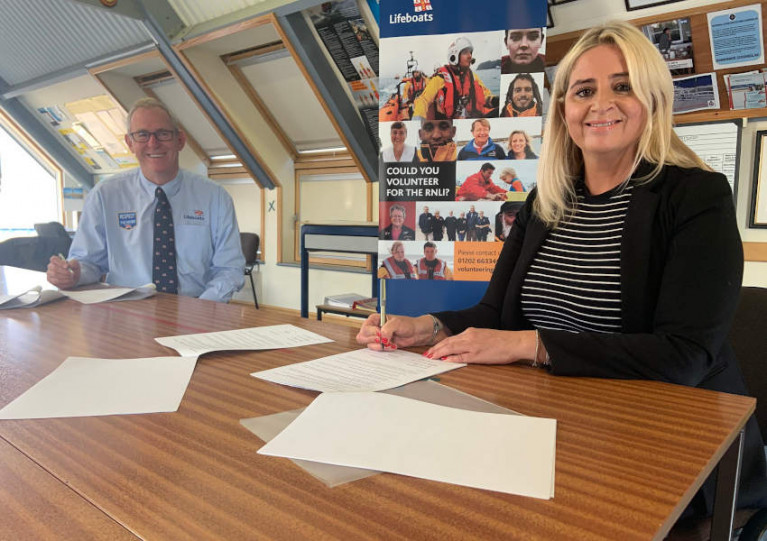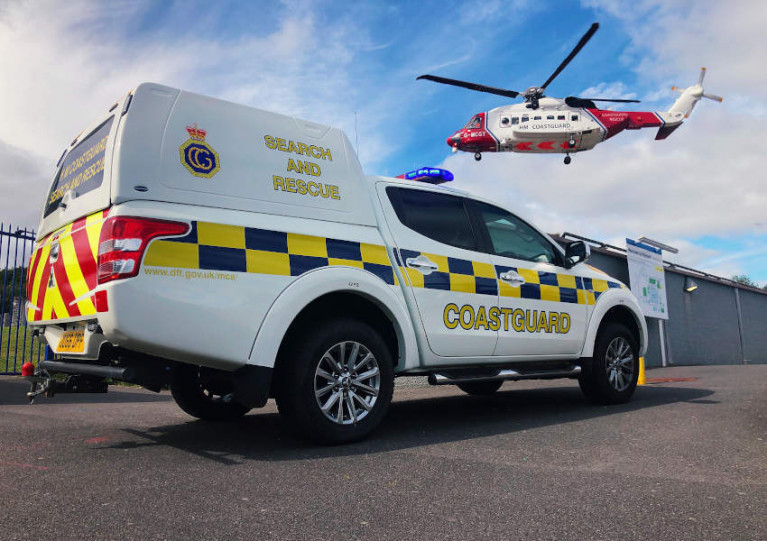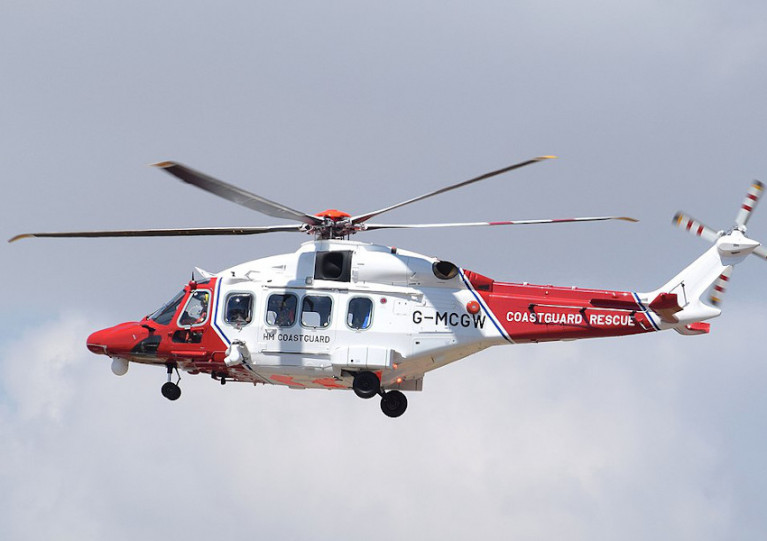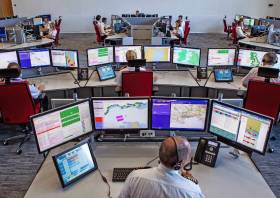Displaying items by tag: HM Coastguard
’Not Worth Risking Your Life for a Selfie’, HM Coastguard Warns After Videos Shared of Person Swept Off Feet by Wave During Storm Ciarán
The UK’s coastguard has warned the public to take safety at the water seriously after videos were shared online of people walking into danger on Whitby’s East Pier as Storm Ciarán lashed the country this week.
As Marine Industry News reports, one video showed a woman being swept off her feet by a wave that crashed across the pier, which was since temporarily closed to public access.
In a statement, Steve Hart, senior coastal operations officer for HM Coastguard said: “Our advice is if there is a storm weather warning in place and if you don’t need to travel, just stay in.
@coffeemad74 the stupidity of some people baffles me. #respectnature #stupidpeople ♬ original sound - itsonlyme
“It’s not worth risking your life for a picture or a selfie and it’s not worth risking our volunteers lives either, who would potentially have to go out on a rescue and pull you out of the water.”
Marine Industry News has more on the story HERE.
Lifesaving defibrillators are being put in some of the most remote UK communities thanks to HM Coastguard.
Automatic External Defibrillators (AEDs) have been put in HM Coastguard’s vehicles and in its stations, creating the largest geographical spread of all emergency services.
It means extra lifesaving capability at emergencies and helps to fill some critical ‘gaps’ to bring access to AEDs for people in the UK’s most remote communities.
Nearly 500 AEDs are now available in Her Majesty’s Coastguard’s emergency response and support vehicles, coastal officer and divisional commander vehicles and all its rescue coordination centres. And AEDs are also in all other buildings belonging to the Maritime and Coastguard Agency, including marine offices around the UK, adding extra protection for employees in the event of heart-related ill health at work.
Dr Paddy Morgan, HM Coastguard’s Medical Director said that the introduction of AEDs can help people in local communities, as well as for coastal incidents:
“Minutes really do matter in the event of a cardiac arrest and having rapid access to an AED can make a significant difference to the chances of someone going home to their loved one or not. Working with our partners in the other emergency services, we have become an integral part of the network that reduces the time to effective defibrillation for people in our communities in an emergency,” he said.
Chief Coastguard of Her Majesty’s Coastguard, Peter Mizen said: “For over 200 years, our aim has been to keep people safe at the coast and out at sea and looking after those around us as well as our own people is intrinsic to that.
“As the national maritime emergency service, we have a wider role to play as part of local communities, often in remote and rural locations where we provide essential support for our emergency services partners. By carrying them in our vehicles, it also means they are immediately on hand for our teams who may come across emergencies on their regular safety patrols and when we attend public events,” he said.
HM Coastguard Celebrates Landmark Birthday
From its beginnings with coastal lookouts to today’s hi-tech national network of coordination centres, from small localised beginnings to international players – one thing has stayed the same for two centuries – Her Majesty’s Coastguard seeks to search, to rescue and to save.
Two hundred years of saving lives along the UK coast and at sea, as well as coordinating rescues for those in distress in international waters, is being marked this year as HM Coastguard celebrates its milestone anniversary.
It was on 15 January 1822, that HM Coastguard was formally brought into existence and has been working to keep people safe at the coast and sea ever since.
On 15 January in honour of that actual birthday, coastguards across all four home nations cast throwlines as a symbol of the service’s dedication - past and present.
Throwlines, which form part of the lifesaving kit used by coastguard teams, were cast into the seas around England, Scotland, Wales and Northern Ireland at 11am, with each team operating under the latest COVID-19 guidance for the local areas.
Over the past two centuries, HM Coastguard has gone from strength to strength. In 2022, coastguard operations centres coordinate responses to emergency situations at the coast calling on 310 Coastguard Rescue Teams – made up of 3500 dedicated volunteers – and using 10 search and rescue helicopter bases.
Although the way in which we operate has changed beyond recognition in the last two centuries, HM Coastguard continues to look to the future. Innovation has always been a driver – whether it be pushing forward state of the art technology in the national network of maritime rescue coordination centres or leading the way in rope, water and mud techniques.
Last month (December) HM Coastguard began to implement its new updated search and rescue radio network which uses fibre technology. More than £175million has been invested to upgrade the Coastguard’s national radio network across all 165 sites over the next two years. This will improve and future proof its communication infrastructure and ensure that it remains able to communicate and exchange data quickly and reliably in order to co-ordinate rescues and save lives.
The service continues to adapt to changes – in the last few years providing mutual aid and support during events and incidents to other emergency partners. During the pandemic, coastguards supported the NHS, attended the G7 and COP26 in 2021 and are called in to support during national emergencies including flooding or supplying water to stranded drivers.
HM Coastguard provides training to search and rescue authorities around the world and also shares knowledge on a mutual basis with others. A key player with the International Maritime Organization, HM Coastguard's input and insight around the obligations of SOLAS (The International Convention for the Safety of Life at Sea) is sought and valued.
The service is currently working hard to reduce its carbon footprint and is aiming to make its UK-wide fleet of vehicles electric wherever possible over the next five years.
Following trials, six electric vehicles have already been purchased, with 19 more currently being procured for use across the UK. Opportunities to electrify the fleet where operationally possible continue to be identified, with the trialling and integrating of electric models as they arrive on the market.
And with technology ever evolving, the service will continue to strive to be at the forefront of innovation to carry out its life-saving work.
Maritime Minister, Robert Courts said: “Congratulations HM Coastguard on their 200-year anniversary. I am immensely proud and humbled by the continued dedication and professionalism from the staff and volunteers which ensures everyone’s safety on our shores and around our coast.
“HM Coastguard is the backbone of our maritime sector and the nation is indebted to its incredible workforce which continues to deliver an exceptional service.”
Claire Hughes, Director of HM Coastguard said: “When you look at how we started and where we are now, it’s easy to celebrate the innovation and development that can be seen throughout the service. And yet, we are far more proud of the people, the volunteers and the staff who throughout two centuries have continued to strive to keep people safe at the coast and out at sea. We always have and always will respond to those in distress.
“While this milestone is an opportunity for us to look back with pride on what we’ve achieved, we have always looked to the future, and I’m proud that we continue to look for ways in which to improve and save lives. I’m proud of the commitment, the dedication and selfless sacrifice and I’m proud of how the service has developed and continues to do so.”
Coastal Operations Area Commander Tom Wright said: “This anniversary is a huge milestone for all of us at HM Coastguard. We wanted to mark the occasion in a way which is unique to us and which demonstrates our commitment to keeping people safe at sea. The symbolic casting of throwlines across the UK today is a reflection of that commitment. "
Two Swimmers Rescued From Belfast Lough During Christmas Day Swim
Two open water swimmers who got into difficulty during their Christmas Day swim near Bangor in Northern Ireland have been praised for wearing kit that made it easier to find them.
The pair were reported to be having problems in Belfast Lough off Grey Point Fort in Helen’s Bay by a passer-by who called 999 and asked for the coastguard.
Bangor and Portaferry Coastguard Rescue Teams and Bangor RNLI’s lifeboat were both sent, along with paramedics, Air Ambulance NI and PSNI.
One of the swimmers made it to shore by themselves and was treated by coastguard personnel, while the other was rescued from the water by Bangor lifeboat. Both were handed into the care of the NI Ambulance Service.
Jude McNeice of HM Coastguard said: “The fact that both swimmers were wearing tow floats made it much easier to locate them.
“Even the most experienced swimmer can be caught out by a change in the conditions and we’d always urge open water swimmers to make sure they have kit like this before taking to the water. It could save your life.”
Commenting on the incident on social media, Bangor RNLI said: “On Facebook there are a number of comments critical of the two swimmers, but Bangor RNLI won’t be joining in.
“We can be pretty sure the casualties did not leave home planning to be reckless and requiring rescue; they just got into difficulty and almost paid the ultimate price. They have our amazing rescue services to thank for still being with us.”
RNLI & HM Coastguard Sign Memorandum Of Understanding For Search & Rescue In The UK
The RNLI and HM Coastguard have signed a memorandum of understanding (MOU) that lays out each organisation’s responsibilities for search and rescue operations in England, Wales, Scotland and Northern Ireland.
John Payne, director of lifesaving operations for the RNLI, and HM Coastguard director Claire Hughes met at Dover Lifeboat Station yesterday (Thursday 1 October) to sign the MOU which the UK coastguard service says demonstrates both sides’ “commitment to joint working and building on what is a very positive relationship”.
It’s hoped the agreement will bear fruit in terms of joint training and regular communication that will ultimately save lives around the UK’s coastlines and inland waters.
“The close working relationship we have with the RNLI is very special and the signing of this MOU exhibits our continued collaboration and dedication to preventing loss of life at sea and along the coast,” Hughes said.
Payne added: “The RNLI is the charity that saves lives at sea and our close co-operation with our tasking agency in the UK, HM Coastguard, helps to make this possible.
“Our volunteer lifeboat crews and staff work side-by-side on search and rescue operations with HM Coastguard teams up and down the UK’s coastline and we are pleased to officially recognise this relationship.”
HM Coastguard dealt with 340 individual incidents across England, Wales, Scotland and Northern Ireland on Saturday (8 August), representing its highest number of call-outs in a single day for well over four years.
Packed coastlines and beaches kept coastguard personnel very busy throughout another hot heatwave day, which saw rescue teams attend 221 incidents.
Both the RNLI and independent lifeboats were called out on 155 occasions combined, and aircraft were also used to assist at the coast and sea in 30 incidents.
HM Coastguard responded to 186 emergency calls and co-ordinated search and rescue responses to a wide-range of incidents, which included people being cut off by the tide and children swept out to sea on inflatables.
In total, the service rescued 146 people and assisted a further 371 people.
Saturday’s incident count represents a significant 145% increase when compared to the average amount of call-outs we recorded throughout August 2019.
The count also surpasses its previous (and recent) busiest day over the past few years, on Friday 31 July the previous weekend, when the service co-ordinated 329 incidents.
‘We don’t want you to remember your day out for all the wrong reasons’
HM Coastguard’s head of coastguard operations Richard Hackwell said: “We have seen a big rise in incident numbers this weekend as more people visit coastal areas and head to the beach.
“We understand that people want to have fun at the coast and enjoy the heatwave but we urge everyone to respect the sea and take responsibility in helping to ensure the safety of themselves, friends and family.
“We’re heading into a period of more good weather so we want to remind you to check and double check tide times as even the most experienced swimmer or keen watersports enthusiast can get caught out by currents and tides. Plan your day out, always exercise caution and make sure you have a way of contacting us if you get into trouble.”
He added: “As our latest statistics show, we’ll always respond when someone calls 999 and asks for the coastguard but help us to help you by not making choices which could put yourself and others at risk.
“Every time our frontline teams respond — as they always do and always will — please don't forget that they're also put at risk too. Take extra care at the coast today and over the coming days. We don’t want you to remember your day out for all the wrong reasons.”
Coastguard rescue teams around Great Britain and Northern Ireland were called to nearly 200 incidents over the weekend, to come to the aid of those who found themselves in difficulty in the sea or at the coast.
The 194 incidents included inflatables drifting offshore; crashed and broken down jet skis and pleasure boats; people injured while out walking or cycling along the coast; paddle boarders, kayakers, windsurfers and kite surfers who found themselves in difficulty; and people cut off by the tide or stuck in mud.
There were 84 callouts on Saturday (16 May) and a further 109 on Sunday (17 May), which proved to be the second busiest day of the year so far for HM Coastguard, as significant numbers of people took to the water and visited the coast.
In addition, 119 teams carried out proactive patrols of English beaches, cliffs and marinas to look out for anyone in trouble, offer safety advice where needed and ensure that people are staying safe in the water after the relaxing of some UK government guidelines in England.
‘The sea can still catch you out and can be unmerciful when it does’
The teams also assisted in providing mutual aid on 38 occasions in support of the other emergency services.
Boating, swimming and other sea-based activities are now allowed once again in England under UK government guidelines. In Northern Ireland, Scotland and Wales, the lockdown remains and people should continue to follow the guidance to stay home.
HM Coastguard director Claire Hughes said: “In England, now more than ever, people need to respect the sea and the coast. While people are now allowed to go out on and in the water, they need to make sure they are safe and protected and have a way to contact HM Coastguard if they get into difficulty.
“Regardless of how well you know the coast and of your ability in your chosen sport, the sea can still catch you out and can be unmerciful when it does.
“In addition, the government guidelines around social distancing should continue to be observed by everyone in the UK.”
The number of recorded incidents dealt with by HM Coastguard yesterday has been the highest since the UK was put into lockdown due to the coronavirus pandemic in late March, the service has warned.
Friday 8 May saw 97 incidents — a 54% increase over the daily average in the previous month — within a single 24-hour period. This coincided with the start of the UK’s early May bank holiday weekend.
“People are ignoring the measures put into place by the [UK] government,” said Matt Leat, duty commander with HM Coastguard.
“I completely understand that the weather and the bank holiday coupled with the fact that we’ve been in this lockdown situation for just over six weeks has tempted people out to our beautiful coasts.
“However, as the government said only yesterday, it’s really vital that we all continue to observe the guidance.”
Leet said that the coastguard would always respond to a 999 or distress call “but the minute we send in a rescue response, we’re putting our frontline responders at risk as well as putting the NHS under avoidable pressure”.
He added: “Please, please continue to observe the #StayHomeSaveLives message — it’s still in place for a reason. Exercise locally and stretch your legs, not our resources.”
UK Prime Minister Boris Johnson has been criticised today (Sunday 10 May) for changing the coronavirus advice slogan from ‘stay at home’ to the less direct ‘stay alert’. The change has been rejected by the devolved institutions in Scotland, Wales and Northern Ireland.
Eight Kayakers Rescued From Strangford Lough
Portaferry’s coastguard rescue team was paged yesterday morning (Saturday 7 March) to a report of multiple kayakers capsized in the water off Killyleagh on Strangford Lough.
Portaferry RNLI were also tasked to the incident, recovering four individuals from the water and locating two more on Don O’Neill Island.
Another two were found on Island Taggart, and they were winched to safety by HM Coastguard rescue helicopter R199 based in Prestwick, south of Glasgow in Scotland.
The casualties were then taken to Killyleagh where Bangor Coastguard Rescue Team had set up a landing point.
The Northern Ireland Ambulance Service also tasked the Air Ambulance NI and Hazard Area Response Team to the scene.
All eight persons were checked over by the doctor and paramedics, with no further treatment needed.
“Well done to all emergency services involved in this incident and a good outcome in the end,” Portaferry Coastguard Rescue Team said.
Following the rescue, as BBC News reports, the Maritime and Coastguard Agency issued general advice to kayakers.
“We’d always recommend that kayakers tell someone at home their passage plan including points of arrival and departure, timescale and any other relevant information.
“It would also be advisable to consider advising the coastguard of your intentions and any deviation of your plans.
“You should also carry a VHF marine band radio and/or PLB (personal locator beacon).”
Superyacht Sinking In Indonesia Sparks International Search Operation
HM Coastguard in the UK was among the agencies joining an international search operation last night (Friday 22 November) after a superyacht sank off Indonesia.
While initially believed to be a UK-registered vessel, it was quickly confirmed that the yacht, named Asia, was a Malaysian-registered sailing vessel with two British citizens among the four people aboard.
Following “extensive investigation work” by HM Coastguard, contact was made with the boat’s skipper at 5am this morning (Saturday 23 November).
He confirmed that the vessel sank after hitting an object in the water some 55 nautical miles off an Indonesian island, but all four crew had managed to get in board its RIB tender and were met by marine police at the nearest landfall.
“We are relieved to hear that the crew are now safely ashore,” said HM Coastguard Controller David Jones, who was in charge of co-ordinating efforts overnight.
“This incident demonstrated good international working between the UK Maritime Rescue Coordination Centre, JRCC Australia, JRCC Jakarta, USA Mission Control Centre and the UK Foreign and Commonwealth Office.”



































































